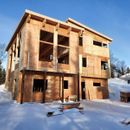Is my sheathing shady?
I had my new house sheathed in 3/4-inch, 5-ply plywood because I’m in a high-risk seismic zone with potential for very high wind (100mph+). The framers used 4×8′ sheets.
A third party reviewer commented that sheathing seams shouldn’t have been placed on corners, and that the sheathing should have overlapped the rim joists (instead, it looks like the framers cut a piece of sheathing to wrap all the way around the joists).
The reviewer suggested that structural issues could be minimized by adding light horizontal strapping above and below windows and across the big living room window dividers. He also suggested running some light vertical strapping over the rim joists to tie the floors together.
These sound like pretty easy fixes, but I’m curious to get GBA’s take. Thanks!
(Location: Anchorage, Alaska)
GBA Detail Library
A collection of one thousand construction details organized by climate and house part










Replies
Paxson,
I will give your post a bump to take it back to the top of the Q&A list.
Paxton,
The intent is to have a continuous shear plane from foundation to roof. That should consist of plywood closely nailed off with all edges falling on the framing or blocking behind. Ideally this is made up of full sheets with the openings cut out, rather than piecing in smaller sections.
Beyond this, on walls with excessive openings the remaining areas of wall need to be detailed as shear-panels to make up for the loss of resistance the openings
cause. Those shear panels typically have specific mechanical connections at their base, and are sometimes pre-made (something like this: https://www.strongtie.com/products/lateral-systems/strong-wall-shearwalls/wood-shearwall ).
Apart from the plywood sheathing, seismic resistance also relies on mechanical connections at the foundation, and roof.
So what does all that mean for your project? It depends on how far you want, or are required to go. The suggestions of the reviewer make sense but I'll tell you what I think based on my projects here in the PNW - remembering that the way to do this properly is to get a structural engineer involved.
- The existing sheathing is probably fine as long as it is nailed off at 3"oc and has backing at all edges.
- The foundation needs to be connected to the shear walls. We typically do this with threaded rods epoxied into the top of the foundation wall and connected to the framing above with something like this: https://www.strongtie.com/sdsscrewholdowns_holdowns/hhdq_holdown/p/hhdq
- The shear walls below and above the rim joist need connecting with straps: https://www.strongtie.com/straightstraps_strapsandties/hrs-st-ps-hst-htp-lsta-lsti-mst-msta-mstc-msti_productgroup_wcc/p/hrs.st.hst.htp.lsta.lsti.mst.msta.mstc.msti
- The walls on elevations with more than 60% openings (measured along their length) need to be designed as shear-panels.
- Depending on the size of the building, some interior walls need to be built as shear walls, in a similar way to the exterior ones.
Thank so much for this reply. The sheathing is heavily nailed, it's just cobbled from a lot of pieces. The walls are anchored to the foundation with big metal Simpson ties, and there are several interior shear walls. I was mostly just curious about all of the seams in the sheathing, as it looks like they made far more cuts than they really needed to.
what is meant by "sheathing seams shouldn’t have been placed on corners?"
Corner of what? Upon first read, I'm thinking, 'you can't wrap a continuous piece of sheathing around a corner.' So I must be missing something. Do you mean the back right of the image where the seams appear very close to the corner? What are those vertical gray lines we're looking at?
Tyler,
I took that to mean the corners of openings. You have the same interdiction when hanging drywall. If you end pieces at the corners, you almost inevitably end up with cracks.
Sorry that wasn't clear. I meant that there shouldn't be seams on the openings (windows or doors) because the corners tend to experience the highest amount of stress.
If the panels are properly edge nailed - the stress are accounted for in the allowable load for the nail spacing - per the code shear tables - your design Engineer can tell you the code forces the building should be designed to.